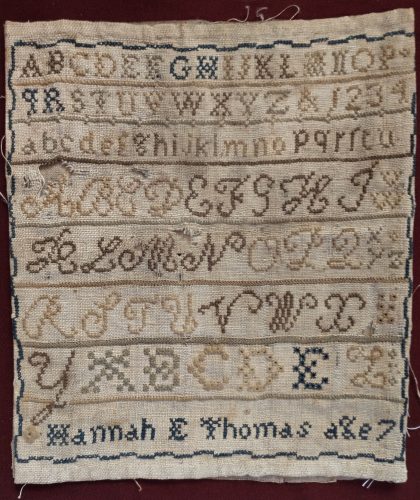 Cross Stitch Sampler 1796, Linen
Cross Stitch Sampler 1796, Linen
This “Marking Sampler” was made by Hannah Eunice Thomas in 1796, when she was just seven years old.
About Cross Stitch Samplers:
A traditional education for an American girl in the 18th century was rarely an option. Girls at that time were expected to grow up, get married, have children, and take care of a home.
Even for boys, unless you were lucky enough to be born into the middle or upper classes, an education in traditional academic subjects was out of reach until the advent of public education in the mid-19th century.
Instead of academic studies, a girl might be tutored in the barest rudiments of reading and arithmetic and, if lucky, might be sent to schools which taught skills which were considered “female accomplishments”, including music, watercolor painting, manners and sewing.
While preparing to take on her future expectations of creating a home and sewing clothes and linens for her future family, most girls completed at least two samplers. A “marking sampler” was usually the first of those two and was most commonly completed when a girl was as young as five or six. It served two purposes – teaching the girl basic embroidery techniques and the alphabet and numbers.
Marking samplers were usually made at home with the guidance of a mother or grandmother. Some girls who were lucky enough to continue their educations at a boarding school would often make a second, more elaborate, decorative sampler or needlework picture. The purpose of this style of sampler was to reveal the values of a girl and her family to potential suitors.
Girls usually signed their samplers, stitching their name, age, and the date the sampler was completed. These small bits of embroidered cloth are often all that remains to testify to the otherwise unrecorded lives of their makers.